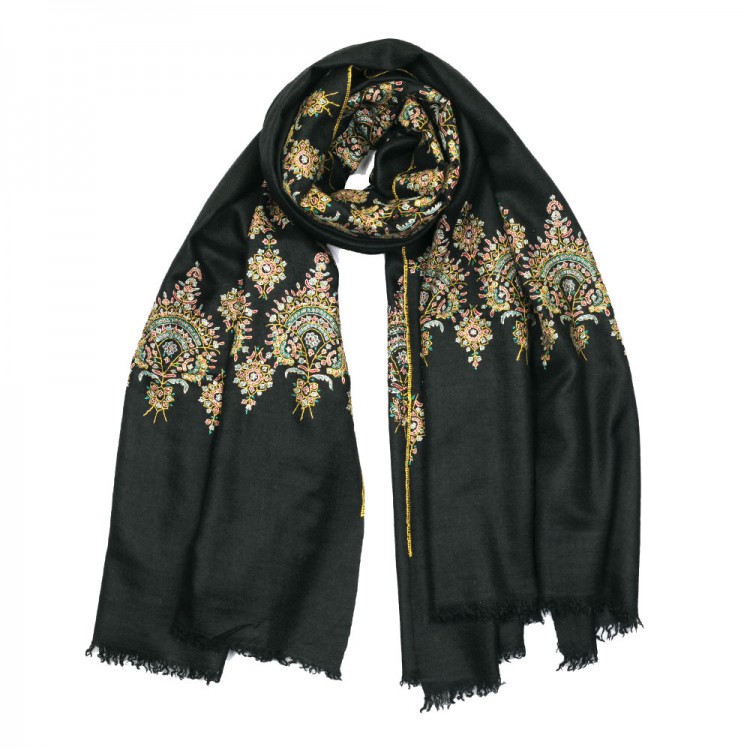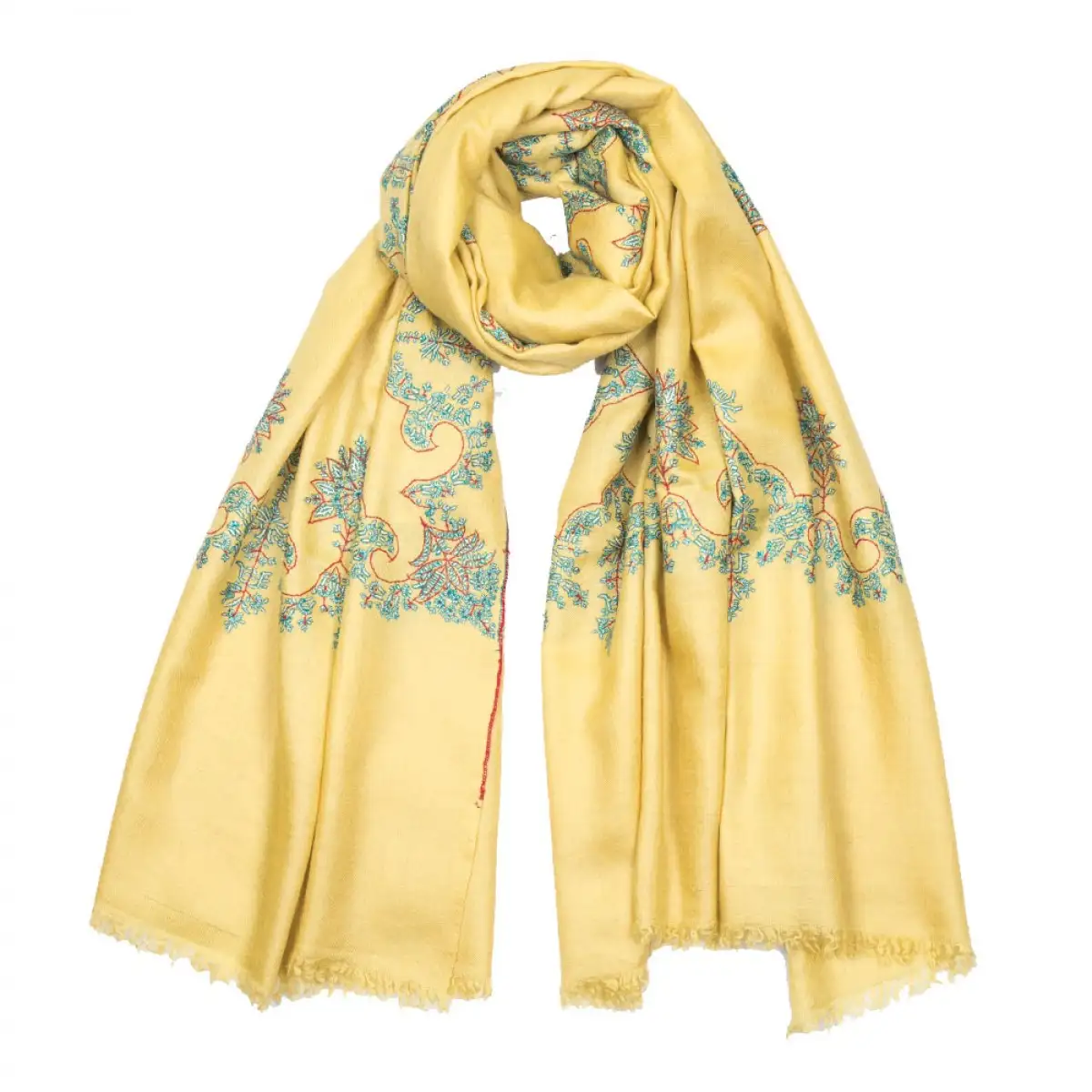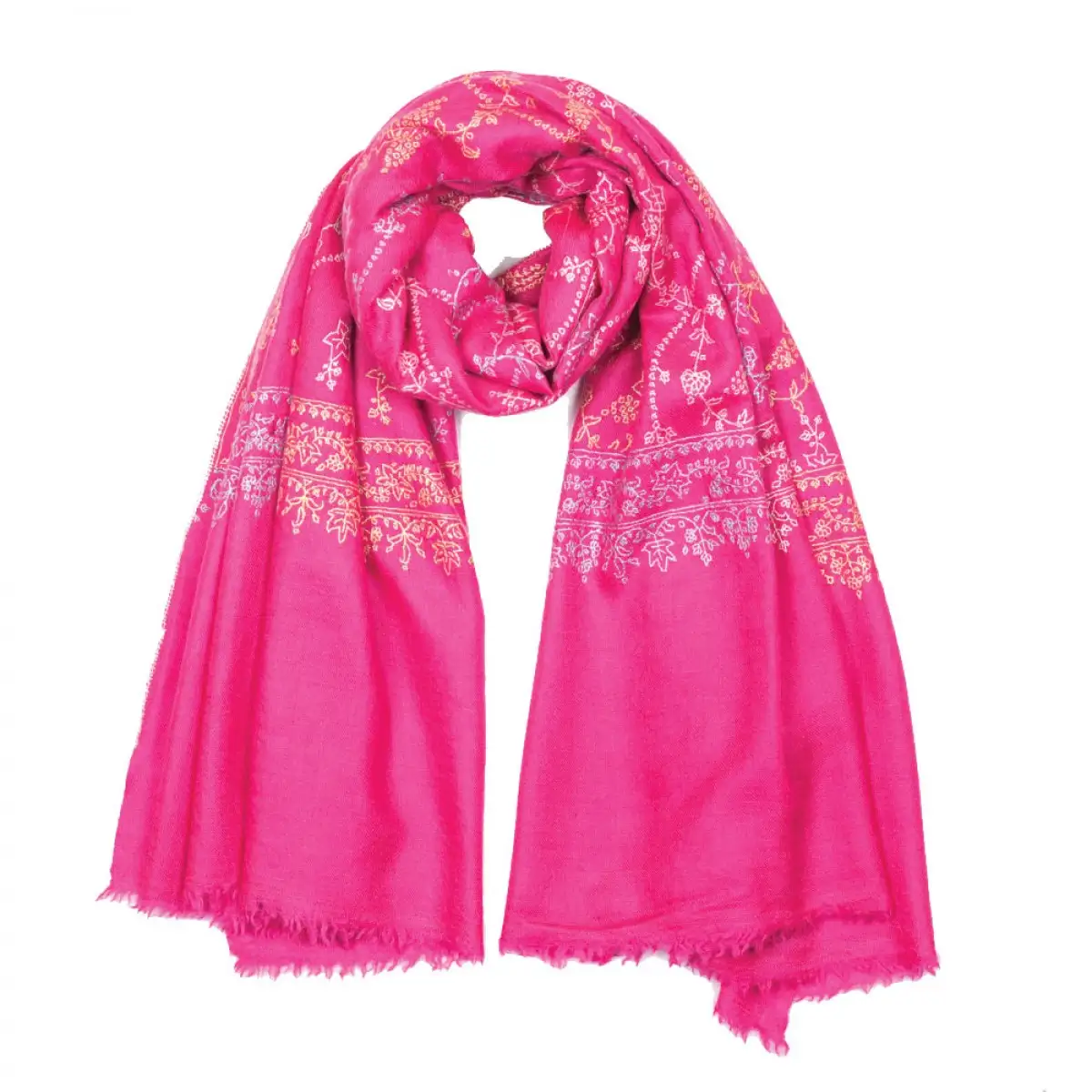
Almost every tourist who visits Jammu & Kashmir adds the Kashmiri embroidery shawl, known for their affluence and regality, to their shopping list. Kashmiri shawls, also known as Cashmere, are made from pashmina wool or shahtoosh and are renowned for their distinctive weave. Aside from India, these beautiful designs have gained immense popularity throughout the world, boosting the cashmere industry in the process. In this article, we will elaborate on the origins of Kashmiri embroidery shawls, how they are made, what kind of embroidery they contain, how to identify, wear, clean and store them, and why they are so popular. Scroll down to read!
A Brief History of Kashmiri Embroidery Shawls
Kashmiri embroidery shawls have been prized for centuries; they were popular in the 15th when Zayn-ul-Abidin enticed weavers from Turkistan to Kashmir to form a cashmere industry, and with Babur, Akbar, Shah Jahan, Safavids, Zands and Qajars rewarding courtiers with Khilat (robe of honour) incorporating pashmina or shahtoosh shawls.
During Ranjit Singh’s rule in Punjab (1819 onwards) these garments grew increasingly popular as allowances or gifts. Later on they became highly sought after by Europe, especially France and Great Britain who showcased them in fashion magazines. Queen Victoria and Empress Josephine owned renowned collections between them. European traders then exported Kashmiri shawls globally as symbols of luxury.

However, the coming of machine-weaving meant that original quality could not be replicated, leading to a drastic decrease in demand – so much so that they almost vanished by the early twentieth century. To save the craft and utilise strong public interest once more, from the beginning of the twenty-first century revising kani weaving was set into motion. This effort was spurred forward when economic reforms began in the 1990s in India.
How Are Kashmiri Embroidery Shawls Made?
Kashmiri shawls are made with traditional techniques passed down through generations. The process starts with gathering wool from Changthangi goats-a species found in the high mountain regions of Tibet and Nepal. This species is quite rare and produces fleece in limited quantities.
The wool is collected during the spring molt, which is then cleaned and sorted for the finest fibers. This is spun into threads either by hand or spinning wheels before being expertly woven on handlooms into intricate patterns and designs.
Furthermore, artisans employ needlework to add decorative motifs and paisleys, flowers, and borders to the shawl’s finish.
Lastly, washing, ironing, and blocking processes are used to enrich their texture and look.
Shawls can be produced through two techniques: loom-woven or kani shawls, and needle-embroidered or sozni shawls.
The basic fabric of either type is typically Shah Tush, Pashmina, or Raffal. Most have heard of Pashmina as cashmere wool; this type comes from a special goat (Capra hircus) living at an altitude of 12000 to 14000 ft cared for by shepherds near the famous Pongkong lake in western Tibet.
Shah Tush (the “King of Wool”) passes through a ring and is also known as Ring Shawl – it derived from a rare Tibetan antelope found at heights of over 14000 ft in the Himalayas. Raffal is spun from marino wool tops, and has become increasingly popular. Needle embroidered shawls often feature floral motifs such as Neemdoor, Doordaar, Paladaar, Baildaar, Jaalis and Jammas. Weaving kanis shawls employs small eyeless bobbins rather than a shuttle.

Types of Kashmiri Embroidery Shawls
There are basically two broad divisions of Kashmiri shawls from a fabric perspective; Wool Shawls, Pashmina shawls. Each of these styles vary in their production techniques, raw materials used as well as the cost and quality – with Wool Shawls being suitable for everyday wear while Pashmina shawls are best suited for special occasions. The latter is especially expensive and hard to find due to its delicate nature.
Kashmiri woollen shawls
These are renowned for their high quality. Crafted from luxurious merino wool with 19 to 21 micron fibres, they are exceptionally soft and durable. Their strong fabric base is ideal for exquisite Aari embroidery (Kasheeda Kari) and ensures beautiful detail even on the thickest of designs. Prices vary depending on the intricacy of the pattern and the type of embroidery used.
Kashmir’s Pashmina shawls
These are second to none – the quality is unrivaled and they’re the only type in Kashmir that don’t face a ban. The shawls are handmade from the soft down fibre of a Capra hircus goat, which grows for extra warmth in Ladakh’s cold climate during its moulting period in Spring. Herders collect this fine hair and ultimately craft it into luxurious shawls.
Raw Cashmere obtained from goats is incredibly fine – measuring 12 to 16 microns in diameter. This makes Pashmina shawls lightweight, soft and delicate. The process of manufacturing these shawls requires rigorous labour- intensive cleaning of the wool, followed by manual processing that may take days, months or even years, depending on the type.

The skillful workmanship of the artisans culminates in luxurious Pashmina shawls which are synonymous with Kashmiri shawls; wool shawls lacking popularity and Shahtoosh being banned. Since they cannot withstand machine embroidery, hand embroidery is the only technique used to adorn Pashmina shawls, done with lightweight threads & thin needles that might take a considerable amount of time to complete!
Different Types Of Hand Embroideries On Kashmiri Shawls
Kashmiri shawls are famous for their lovely hand embroidery, which come in a myraid of styles. From classic floral motifs to spectacular geometrical patterns, the intricate craftsmanship of these pieces imbue them with an unparalleled beauty and aesthetic appeal that is highly sought after.
Here are the most popular types of hand embroideries found on Kashmiri Shawls:
Sozni Embroidery
Pashmina shawls are embellished with Sozni needlepoint embroidery to resemble tapestries. It is the only needlework technique practiced in Kashmir. Shah Hamda (RA) introduced it to Kashmir in the 14th century. Local dialects also refer to it as Sozni Kaem, Kani Sozni or setchzinikaem.
Papier mache embroidery
It is an often-used technique for adorning shawls and stoles. This composite material, derived from the French ‘papier-mâché’, meaning ‘chewed paper’, was especially popular in the nineteenth century. Strips of it are cut into shapes, then stitched onto cloth to form a pattern, which can be enhanced further with colourful beads, threads and sequins.

Aari Embroidery
Also referred to as crewelwork, this is a highly intricate and traditional form of embroidery found on Kashmiri shawls. An aari hooking needle is used to create fine, detailed designs featuring floral motifs, paisleys and complex patterns.

Needlework embroidery
It is a broad term that covers the diverse stitching techniques used to adorn Kashmiri shawls. These include chain stitch, satin stitch, herringbone stitch and additional methods. By means of these stitches, exquisite floral, paisley and geometric designs are achieved on the material.

Kani embroidery
It is an exquisite technique involving the weaving of intricate motifs and patterns into pashmina shawls. This unique form of embroidery makes use of special looms as well as small wooden sticks known as kanis which are operated manually to generate the desired design.
Also read: Kani Shawl of Kashmir: History, Making Process and Pics

Tilla embroidery (Zari embroidery)
In this, gold or silver threads are either woven into the fabric or sewn on top. This technique results in intricate designs that add a luxe glimmer to Kashmiri shawls.

Reasons Behind The Popularity Of Kashmir Shawls
Since ancient times, Kashmiri shawls have been associated with luxury and opulence. There are certain reasons for their popularity:
- Procuring Cashmere wool from the Himalayan Changthangi goats is a lengthy and labor-intensive process, which is only possible due to the skilled artisans of Kashmir who have perfected their craft since it was first produced by Syed Ali Hamdani in the 15th century.
- It takes several days for an authentic Pashmina shawl to take shape. Different artisans gather the finest cashmere yarns, sort them based on the texture, and then spend time spinning and weaving it into a masterpiece.
Kashmiri Shawls are highly sought-after items, both domestically and around the world. This lovingly crafted garment is renowned for its finesse, intricate embroidery designs and timelessness. It remains popular due to its ability to adapt to changing trends and eras. Further, their timeless look works well with both traditional and western outfits.
This is not only a great fashion statement, but it also supports and encourages the Kashmiri artisans who depend on it for their living. People who visit Kashmir should buy these unique pieces to save our cultural heritage, as well as to help those in need.
FAQ – Kashmir Shawl
How To Identify a Kashmir Shawl?
To identify your shawl is genuine Pashmina, start by burning a single thread from the fringe and testing the ashes. If they are powdery in nature, chances are the fabric is authentic. Have a look at any labels or tags to see how it’s affixed to the fabric – glued on won’t be Pashmina wool. Finally, hold it up against the light – an irregular weave indicates hand loom while evenness suggests machine production.
How To Wear a Kashmir Shawl?
Kashmir shawls have traditionally been worn by both men and women. Depending on the kind of embroidery, they can be draped over the shoulders or wrapped around the body. If only borders are decorated, they may be used like a scarf, or tied at the waist. So, you can have fun experimenting with different folding techniques, tying methods, layering options to create your own distinct look!
Also read: 13 Stylish Ways to Tie and Wear a Pashmina Scarf!
How To Care For Kashmir Shawl?
Kashmiri shawls and embroiders require special treatment and storage — use a mild detergent or wool specialist if you’re not using them for an extended period of time in order to protect their delicate texture and softness. To prevent damage, take out and enjoy your shawls periodically — store them in a dry place away from direct sunlight and wrap them in cotton garments. If it is necessary to clean them, use cashmere detergent.